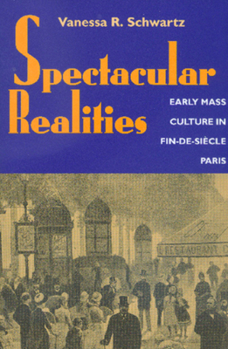Spectacular Realities: Early Mass Culture in Fin-De-Siècle Paris
Select Format
Select Condition 
Book Overview
During the second half of the nineteenth century, Paris emerged as the entertainment capital of the world. The sparkling redesigned city fostered a culture of energetic crowd-pleasing and multi-sensory amusements that would apprehend and represent real life as spectacle.
Vanessa R. Schwartz examines the explosive popularity of such phenomena as the boulevards, the mass press, public displays of corpses at the morgue, wax museums, panoramas,...
Format:Paperback
Language:English
ISBN:0520221680
ISBN13:9780520221680
Release Date:August 1999
Publisher:University of California Press
Length:244 Pages
Weight:0.85 lbs.
Dimensions:0.9" x 5.9" x 8.9"
Customer Reviews
3 ratings
Schwartz is thrilling
Published by Thriftbooks.com User , 14 years ago
She writes like she loves it and can get anyone excited about Modernity and turn of the century Paris through accessible and interesting accounts and a well researched reflective perspective.
Reality and represenation of reality in 19th-century Paris
Published by Thriftbooks.com User , 17 years ago
Reading Vanessa Schwartz's brilliant work Spectacular Realities: Early Mass Culture in Fin-de-Siècle Paris, one can get the feeling that the late nineteenth-century Parisian popular press was as omnipresent as the modern-day paparazzi. Throughout her enchanting narrative of the institutions and behaviors of an evolving mass culture, Schwartz characterizes the news consumption of a newly-literate population from the emerging print media as a key component to the identification of residents and visitors in fin de siècle Paris. The importance of print to Paris's cultural evolution does not preclude significant influences of visual media. In fact, Spectacular Realities argues that the creation and representation of Parisian society "relied on the explicit connection between written and visual texts." Schwartz's driving logic is that "a culture that became 'more literate' also became more visual as word and image generated the spectacular realities described" (3). The book begins with a well-crafted introduction that locates the author's position contra the historical literature emphasizing written or visual texts as opposed cultural forms. Schwartz promptly introduces her post-modern view that "any history is a history of representation" (4) and she succinctly acquaints the reader with the work's star actors (the press, the boulevards, the morgue, the wax museum, panorama, and cinema). Schwartz, then, remains true to the proposed schema and devotes the subsequent 192 pages--with the focus of a steaming locomotive--to conveying perhaps the book's most salient point: "The visual representation of reality as spectacle in late nineteenth-century Paris created a common culture and a sense of shared experiences through which people might begin to imagine themselves as participating in a metropolitan culture because they had visual evidence that such a shared world, of which they were a part, existed" (6). Similar to futurist Alvin Toffler's analysis of the fin de vingtiéme siècle in Powershift: Knowledge, Wealth, and Violence at the Edge of the 21st Century (New York: Bantam Books, 1990) that "knowledge is the most democratic source of power," the popular press of late nineteenth-century Paris empowered individuals to be or become Parisian by describing for them what "Parisian" was. The press, while creating a framework for viewing urban life, did not necessarily create that life. The city's Haussmannian boulevards established a new city center, complete with the displacement of workers and built-in social controls, where, according to a contemporary newspaper, "one can say everything, hear everything and imagine everything" (21). The boulevards provided a forum as an alternate venue for the revolutionary crowds, and the press created an imagined community of the street--a "boulevard culture"--in which the public could play a part. Throughout the book there exists cooperation between reality and the representation of reality. The reinfor
the quintessential book on French cultural history
Published by Thriftbooks.com User , 20 years ago
i read this book for my history class(i am a college student) on european cultural/intellectual history. The author provides you with amazingingly creative and sharp insights on how visual images played a vital role in constructing a new modern metropolitan culture in the late nineteenth century Paris. It is not a book that just rambles about what's "cool" about Paris unlike many other books; it offers a very convincing and methodical explanation and observation on French culture at the trun of the century. If you love Paris, READ THIS BOOK!





